
Ectocarpus siliculosus
False Sea Felt, Brown Tuft
31 August 2024
Harling Point, Juan de Fuca Strait, Vancouver Island, B.C., Canada
Tide: 2.1 feet at 08:41 PDT (measured at Oak Bay Tidal Station)
Weather: Clear, calm, sea smooth, humidity 74%, 15 ˚C.
Moon: Waning Crescent (5.6%, 27 days); Next Phase, New Moon, 2 Sept 2024 at 6:55 pm PDT; Previous Phase, Third Quarter, 26 Aug 2024 at 2:25 am PDT.
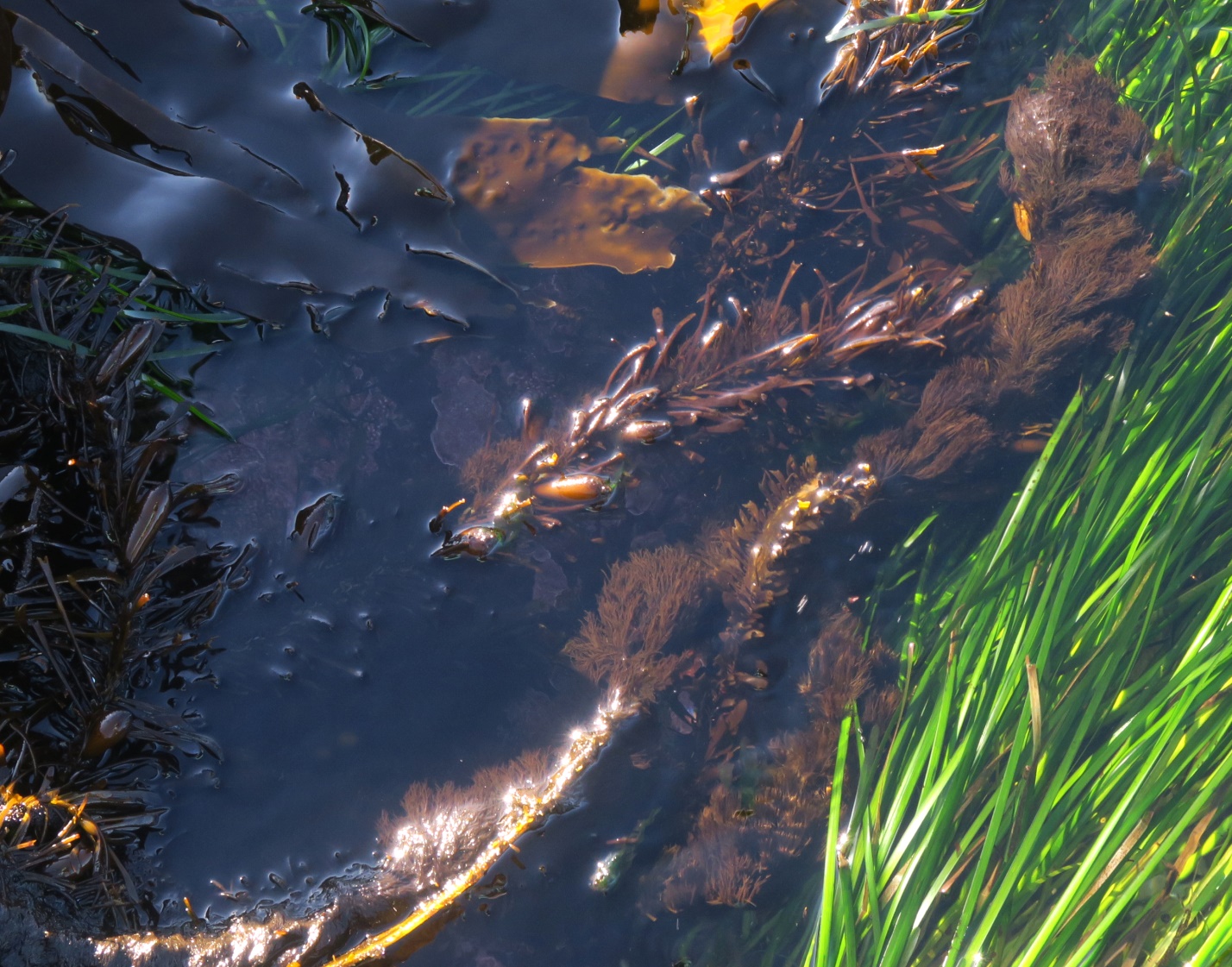
Figure 1: Finely branched tufts of brown alga, Ectocarpus siliculosus, can be seen growing epiphytically along the length of the Egregia menziesii blades here. Look close at the border of the bright green seagrass where the small, multi-branched seaweed is in high contrast; once you see it, you become aware that it is growing in many places. Harling Point, Juan de Fuca Strait, Vancouver Island, B.C., Canada. August 31, 2024. Photo ID 27736 ©Seaweedwhisperings.com
Person 1:
Very tufted in appearance.
Felt like felt.
Very thick, matted essence when out of water.
Smothers, does not simply overwhelm.
We saw it growing profusely on Egregia straps.
When in water Ecto seems to hang down as though trying to drag (influence) the Egregia to do what Ecto wants it to do.
Unfriendly, grumpy, doesn’t want to share, wants to be left alone.
In contrast I wanted to share my binocular with Person 2 so she could have a better look at Ecto in the water.
“Searching in vain” for something it’s been missing. I was determined to find Ecto on seagrass here (not only the Egregia host), but at first this was to no avail. I was also “searching in vain” for a time.
Here today on the seagrass Ecto is not so overwhelming.
Ecto is not on all Egregias either. I wonder if the hosts try to rid themselves of Ecto?
I had constant indecision on whether or not to photograph yet another group of Ecto. I kept taking my camera out, taking pictures and then putting my camera away, and then doing that all over again. I kept changing my mind, back and forth.
I kept looking at this seaweed’s character and found it was a bit confusing; I couldn’t get a definitive sense on what it was all about.
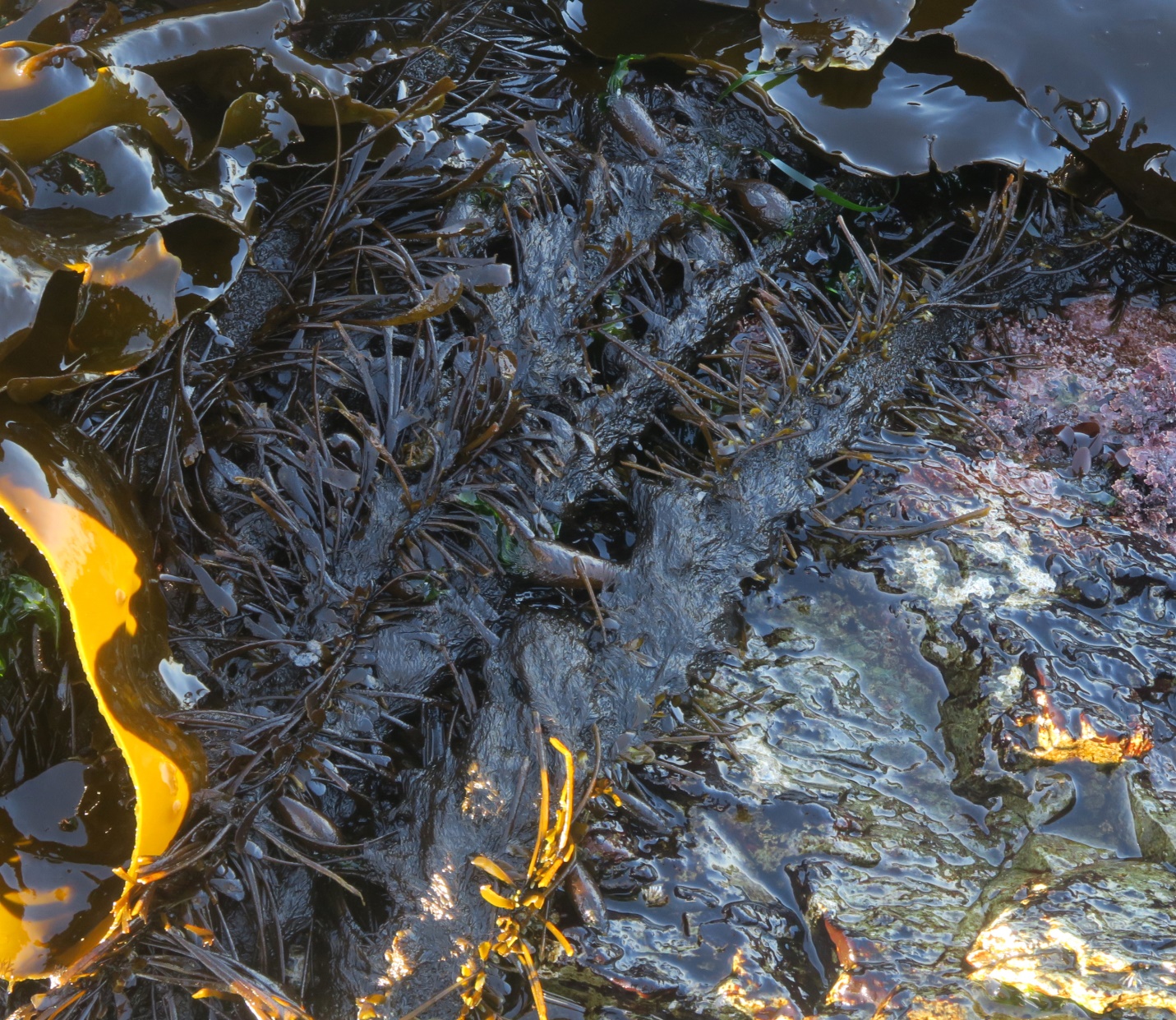
Figure 2: A set of Egregia thalli are stranded on the rocky shore in this photo, if you look at the central straps, between the ‘paddle like extensions’ of the Feather Boa Kelp, you will see the collapsed groupings of False Sea Felt. A filamentous brown, out of water this seaweed has no strength to hold its form. Harling Point, Juan de Fuca Strait, Vancouver Island, B.C., Canada. August 31, 2024. Photo ID 27737 ©Seaweedwhisperings.com
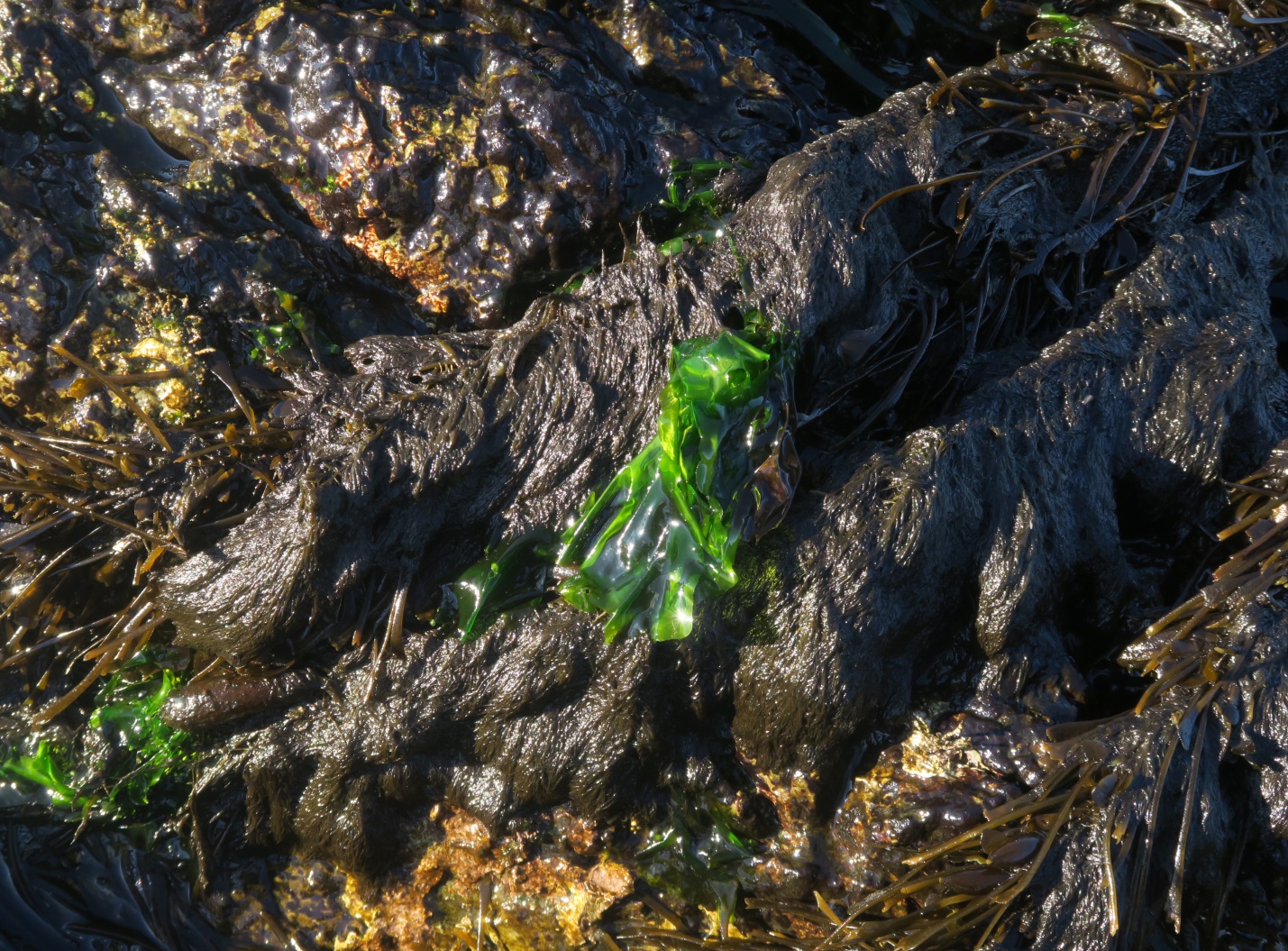
Figure 3: A closer view shows the sodden thalli of Ectocarpus siliculosus. Harling Point, Juan de Fuca Strait, Vancouver Island, B.C., Canada. August 31, 2024. Photo ID 27738 ©Seaweedwhisperings.com
Person 2:
I’d been recently reviewing some seaweed photographs and just yesterday I came to the task of filing to species folders a set of photos of one species seen earlier this year, Ectocarpus siliculosus. And as Person 1 and I were chatting about our upcoming seashore outing this morning, on a day with only a moderately low ‘low tide’, we discussed how we really had no idea which, if any, seaweeds might present today for a Whispering. We were curious to find out.
At Harling Point this morning, the low late August morning light lit up some shallow tide pools that we crossed on the way to the outer edge of the rocky point. In the pools the deep red-brown Prionitis sternbergii and the blood red Hildenbrandia rubra showed their colors vividly. When we reached the outer edge, a place where the rocks drop off into the strait rather abruptly with only a few small efforts at creating ledges, we came to a whole other set of marine macro algae. Here there was healthy growth of Hedophyllum sessile (Sea Cabbage) and also just a bit deeper, the showy yellow-ribbed blades of Alaria marginata (Ribbon Kelp). Less conspicuous by far were many thalli of Egregia menziesii (Feather Boa Kelp), most of which were largely broken and rather battered and worn looking. And, on the ‘straps’ of the Egregia there were groupings of the seaweed I’d just been reviewing – Ectocarpus siliculosus! It was such synchronicity to find it – almost as if it had jumped from my digital photo archives to the intertidal reality that is Harling Point today.
In water Ectocarpus silisulosus is a totally different being than out of it. Immersed, the many small branches fan out their reach and form quite nicely shaped tassels or tufts. These tassels cluster here and there along the main strap of the Egregia host thalli and sometimes they are so dense that you can’t tell what they are growing on. Out of water, left on the rock as the tide is receding this morning, this seaweed collapses, collapses fully as if it has no ‘spine’ at all, and the many filaments lay close to each other in a darker, indistinct-looking mass of some organism that is possibly not even alive or one that has been overtaken by some decomposition process. It can actually look rather ugly, repulsive and somewhat confusing out of water; truly quite the contrast to the immersed state!
I picked up one broken strap of Egregia menziesii which had a rather large cluster of Ectocarpus growing at its tip. This strap had been recently stranded on the rock very near the waterline. The touch of Ectocarpus was surprising; it felt heavy, sodden, and also somewhat sleek and almost well-groomed..., I paused to think what this reminded me of and thought, oh, it’s like a pelt, an otter’s pelt came to mind – a creature that is most at home in the water.
Movement for Ectocarpus comes as a result of the action of its host and this permits what I thought of as ‘play’. Without water currents, ocean swells or host movement, Ecto hangs limply from its attachment – limply but also with some bulk that seems weighty. But watching the Ectocarpus siliculosus fan out and then sleekly pull together, fan out and then sleekly pull together, as the gentle ocean swell pulled the Feather Boa host in repeated undulations, this was entrancing, possibly even a bit tantalizing as I felt a visceral pull to join along in the water with them! I experienced this ‘tug’ every time I let go and “went with” the motion of the Ectocarpus and Egregia duo. I think this little seaweed can exert a big influence if it so chooses.
Ectocarpus siliculosus ‘rides’ on the strength of the Feather Boa. It loves to do this, and it reaches more places in this fashion than it ever possibly could reach on its own. Ecto’s beauty is plainly revealed when it is riding back and forth in the waving action of the sea.
Ecto relies on the strength of its host, for sure, but does it need its own strength to hold on to Feather Boa (or seagrass), too? Sure, certainly, but it feels like its strength is of an entirely different nature. It can ‘dig in’ to avoid the fear of coming off, falling away and losing the ride; and its hold must be secure against forces coming from many directions. Something about this type of strength feels more like strength of will rather than strength of might.
Today Person 1 spent time really searching to see if any of the Ecto was growing on the seagrass here as we had seen it doing earlier in the year at another location. He did find some, and it was smaller in overall size, perhaps younger, and these tufts were found especially on the older seagrass blades.
This feels true of all the hosts, they all are “older”, and in fact they must be in order for them to have first matured enough and then been ‘in place’ long enough for the epiphytic Ecto to later move in and start its own growth cycle on them.
Whether living on Feather Boa or on seagrass, Ectocarpus siliculosus lives right adjacent to some very much ‘prettier’ looking species. With the seagrass it is the Red Fringe, Smithora naiadum, and with the Feather Boa it is the Ribbon Kelp, Alaria marginata. It felt very much like Ectocarpus is attracted to beauty. Possibly this is why it enjoys living near these other species. And the thought occurred – is there a touch of envy involved, too? Yes, envy can be present, in varying degrees but it is also really quite well hidden.
Objectively stated, Ectocarpus siliculosus is simply another “seagrass rider” playing in the same neighbourhood with the showier and more colorful swishing red skirts of Smithora; another epiphytic “rider” that has a different look entirely (See Figure 4 below).
They live on older ones, at least ones older than themselves. It is clear that they value them and it feels like they also admire them. Their tasseled look gives the hint that they have a ‘taste’ for the old-fashioned things and certainly are not interested in aligning with the current trends. The ‘pelt’ idea also links in here. Current opinion scorns those who wear coats made of real fur – but such coats are indeed excellent for keeping warm, and they were in their day one of the finer coats a person could own. A fur coat is an old-fashioned thing, a rather beautiful old-fashioned thing…, and that is just the type of thing this seaweed’s energy type can truly embrace; they embrace it for what it is and also continue to value it even against peer pressure or the opposing values of others. In this area they don’t fall in with the influence of the majority.
It feels to me that this holding onto older and valued things applies to ideas and concepts as well. There is a genuine respect for time proven knowledge and wisdom which has a beauty of another kind. And the “false” aspect of this seaweed’s common name indicates that there must be some discrimination happening too; not everything that is old is valuable, and not everything that is valuable is old. I think this can be confused at times for Ecto just like sometimes the multiple branches, tassels and tufts can look rather ugly and indistinct rather than sleek and well groomed.
This seaweed has many filamentous branches, which branch again themselves and also produce what seem like small hairs (these are only visible to the naked eye as an ‘impression’ of hairs, but are clearly visible upon magnification). So each tuft of Ecto has many branches and countless protrusions and this seems all the better for “collecting things” and, indeed, for grasping them or having ‘places’ to continue to hold or store them.
They are really very pleased if they can combine their love of older things and beautiful things, and their tendency to collect things. This could be like a person who collects old china or silver tableware or hand tools and devices now left behind by digital and electronic replacements. Using what is old fashioned or and what is left behind by the changing times and doing so with pleasure – this is the feeling I sense with this seaweed. They truly appreciate these things and do NOT want them to be trashed.
Ectocarpus siliculosus does well on older seagrass stems or on older Egregia thalli; it does well, but I think its presence does not aid the Egregia or seagrass in any way. In fact my sense was that its presence can accelerate the decline of the host, kelp or grass. This is not intentional, but it does seem to be a real by-product of their association.
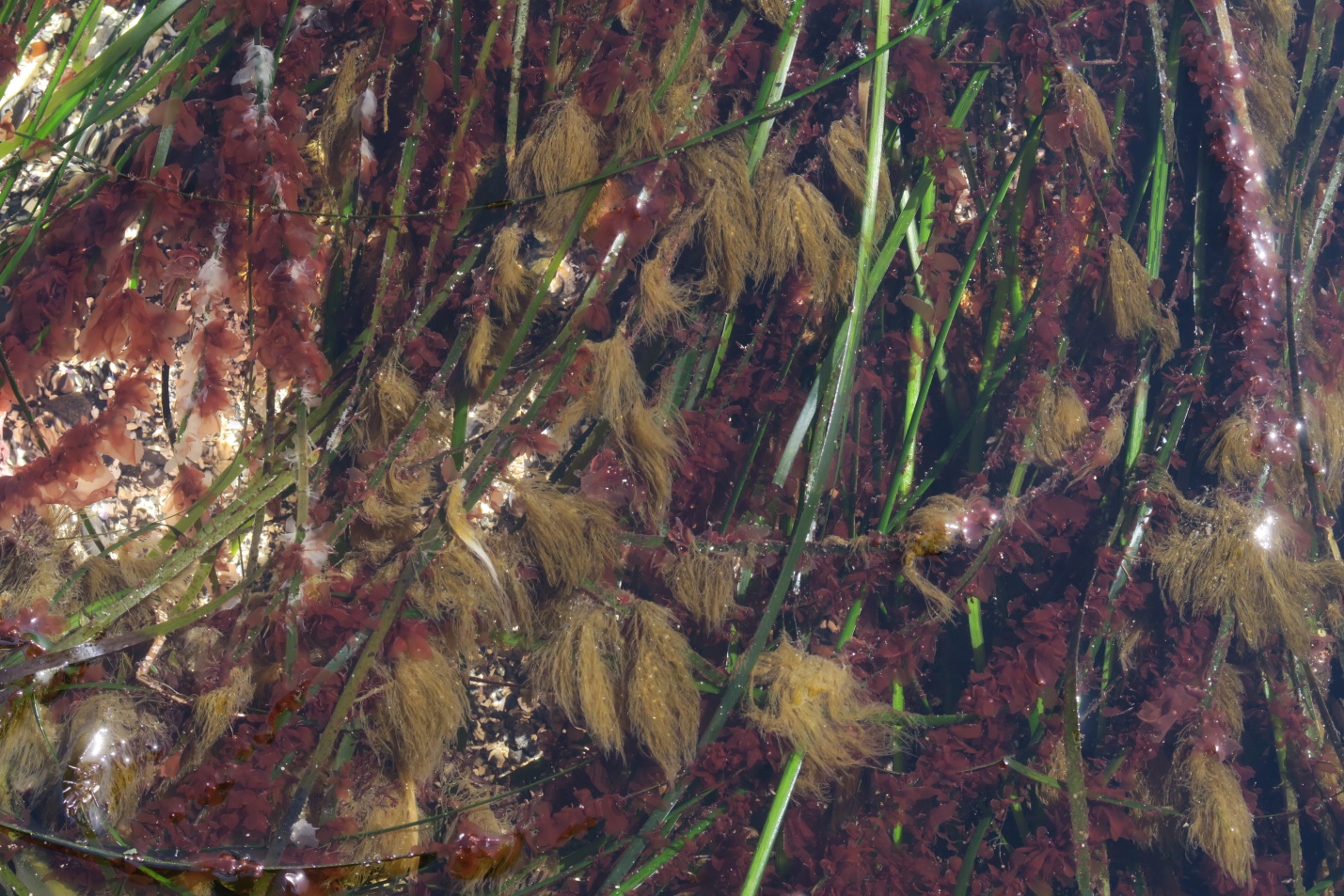
Figure 4: After an early hot spell during a time of consistently gentle seas, conditions were ripe for the seagrass at Big Beach to become abundantly populated by two obvious epiphytes. Here is the frilly red Smithora naiadum, and also the yellowish tassels of Ectocarpus siliculosus. Big Beach, Vancouver Island, B.C., Canada. May 11, 2024. Photo ID 27739 ©Seaweedwhisperings.com
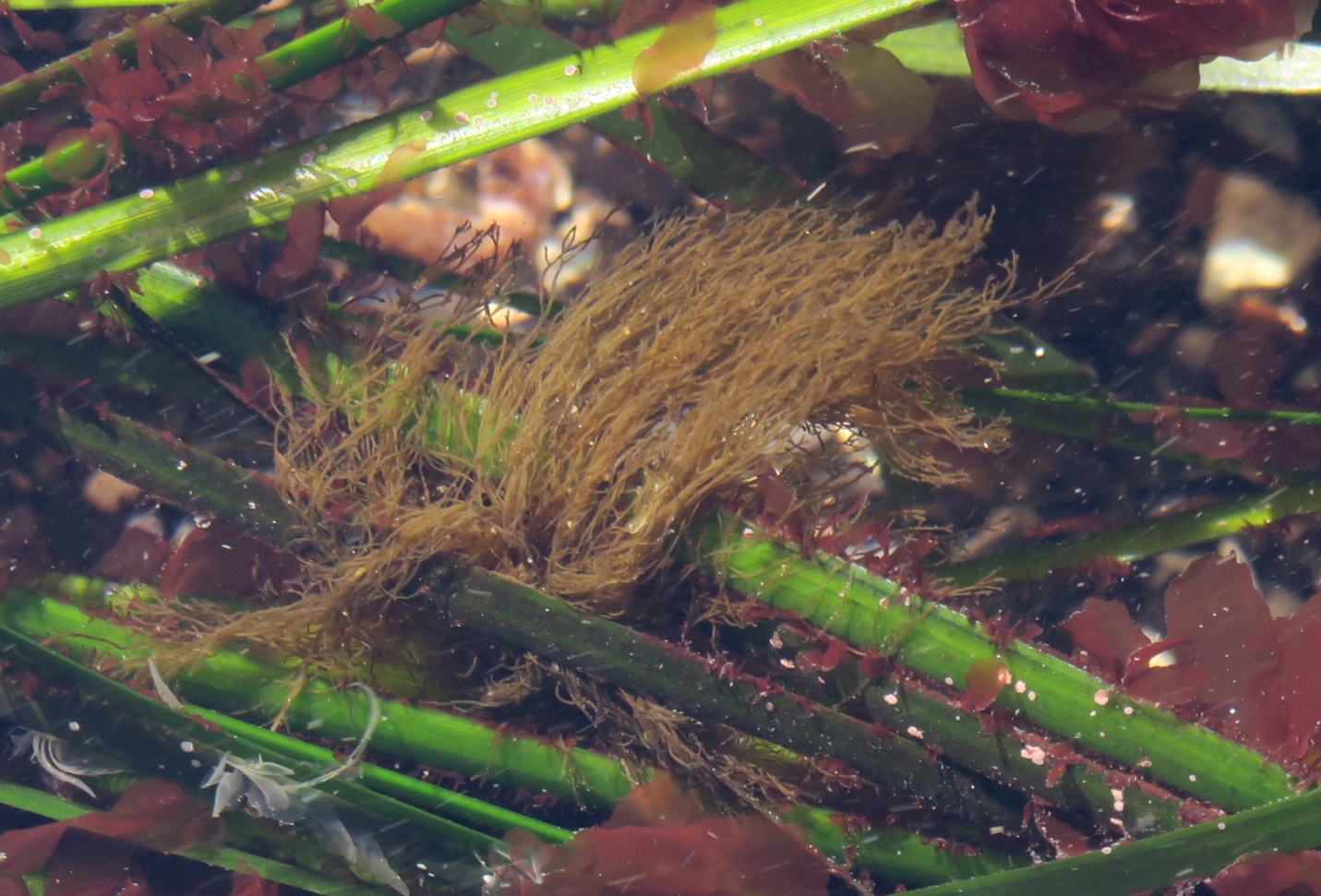
Figure 5: Enlarged here to more than twice life-sized, this view reveals the branching habit of this seaweed. Big Beach, Vancouver Island, B.C., Canada. May 11, 2024. Photo ID 27740 ©Seaweedwhisperings.com
Discussion:
False Sea Felt is one common name for this seaweed; contemplating the name we see that there is something notable about the idea of felt, which is old; it is an old style way of working with wool. Now people would use another method to process raw wool into fiber for making garments, or more likely use a synthetic fiber instead. It is an old-fashioned technique, felting, but also one that makes a totally acceptable yet distinctly different product.
As noted, the physical form of this seaweed seems to be well-designed for collecting and holding things. For a small seaweed it has a surprisingly bulky presence; it holds a lot. Bulky is defined as: taking up much space, typically inconveniently; large and unwieldy. Perhaps there is a challenge with this energy in knowing what to hold onto and what to let go of. Certainly indiscriminately continued or poorly maintained ‘collections’ can only grow larger in size and eventually become unwieldy and inconvenient to house.
What style of ‘work’ suits this type of energy? An obvious answer is collecting things with pleasure and genuine admiration and caring for them, too. In humans this might be like a person who collects first edition books, one who maintains deeds and records, or even a museum curator. They take great care to keep ‘relics’ from the past in good order and accessible for review and study or even for viewing and simple appreciation. Keeping these things, they know, is valuable; it shows plainly the march of time, how things change. They know that there is merit in not forgetting them.
They also know that they have different values than many others. This is something they accept and it does lead them to be selective in who they interact with and how much of themselves that they will openly share. There can be a reticence to them that is quite strong. They won’t bend their beliefs, but they also typically won’t argue openly for them either. Instead they will politely ‘agree to disagree’ and privately simply continue to hold onto their ideals. It feels like their beauty and true nature is shared, again, only very selectively.
They can be quite organized. They will hold on where others would quit or give up.
Particular and measured in what they do and what they say – there’s a strong degree of intention and deliberation in their actions and statements. Sometimes, though, the way they present is a bit heavy or ‘sodden’ and can be bogged down by formal or eccentric language and mannerisms.
They don’t mind a bit of ‘tarnish’ as they see beauty in imperfections.
Like the otter referred to earlier, Ecto can be playful, but for the most part this is quite private. Their play is not necessarily hidden but it also isn’t done for show; it is for personal pleasure. Those closest to them can join in; others won’t even notice this aspect to their character.
They have a lot to offer, but others often find they need to somehow “tap into” that. It isn’t easy to gain their confidence because they have a natural suspicion. Too many experiences have led to their being cast aside for something newer, snazzier, or even something that requires a little less effort to attain. Ecto can also quite effectively and consistently repel others until such time that said others prove their authentic interest. Often times that is very difficult for another to do because Ectocarpus siliculosus has no agenda to convince others to join in with them, and so it is left to the others to “go the extra mile” in proving their intent.
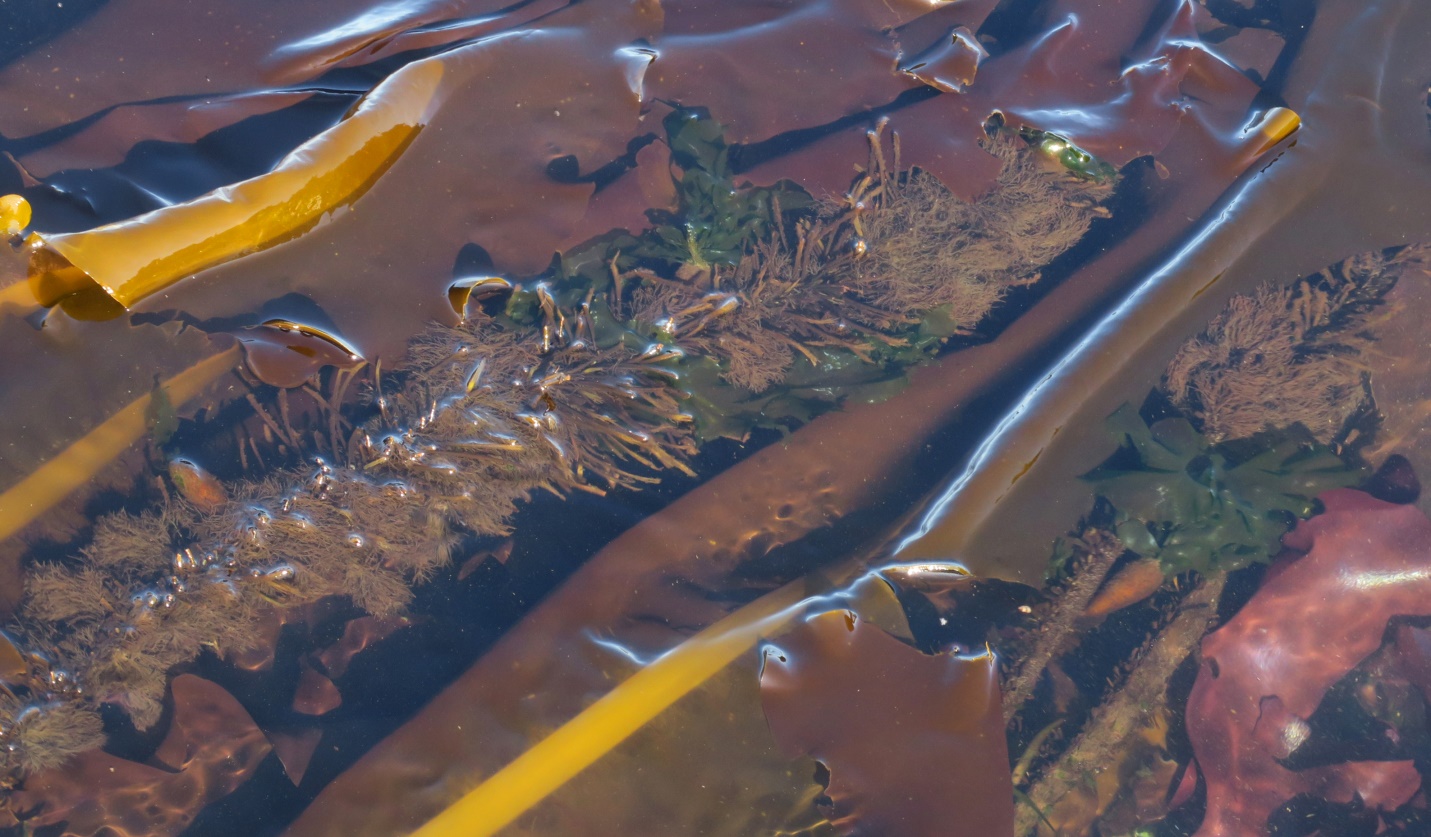
Figure 6: Interspersed with the yellow-ribbed Alaria marginata blades, here portions of two or three Egregia thalli are seen as mainly obscured by the abundant tufts of Ectocarpus siliculosus. Many annual growth seaweeds are getting a bit worn looking by this time of the year, and the Egregia with the Ectocarpus epiphyte looks especially so. Harling Point, Juan de Fuca Strait, Vancouver Island, B.C., Canada. August 31, 2024. Photo ID 27741 ©Seaweedwhisperings.com
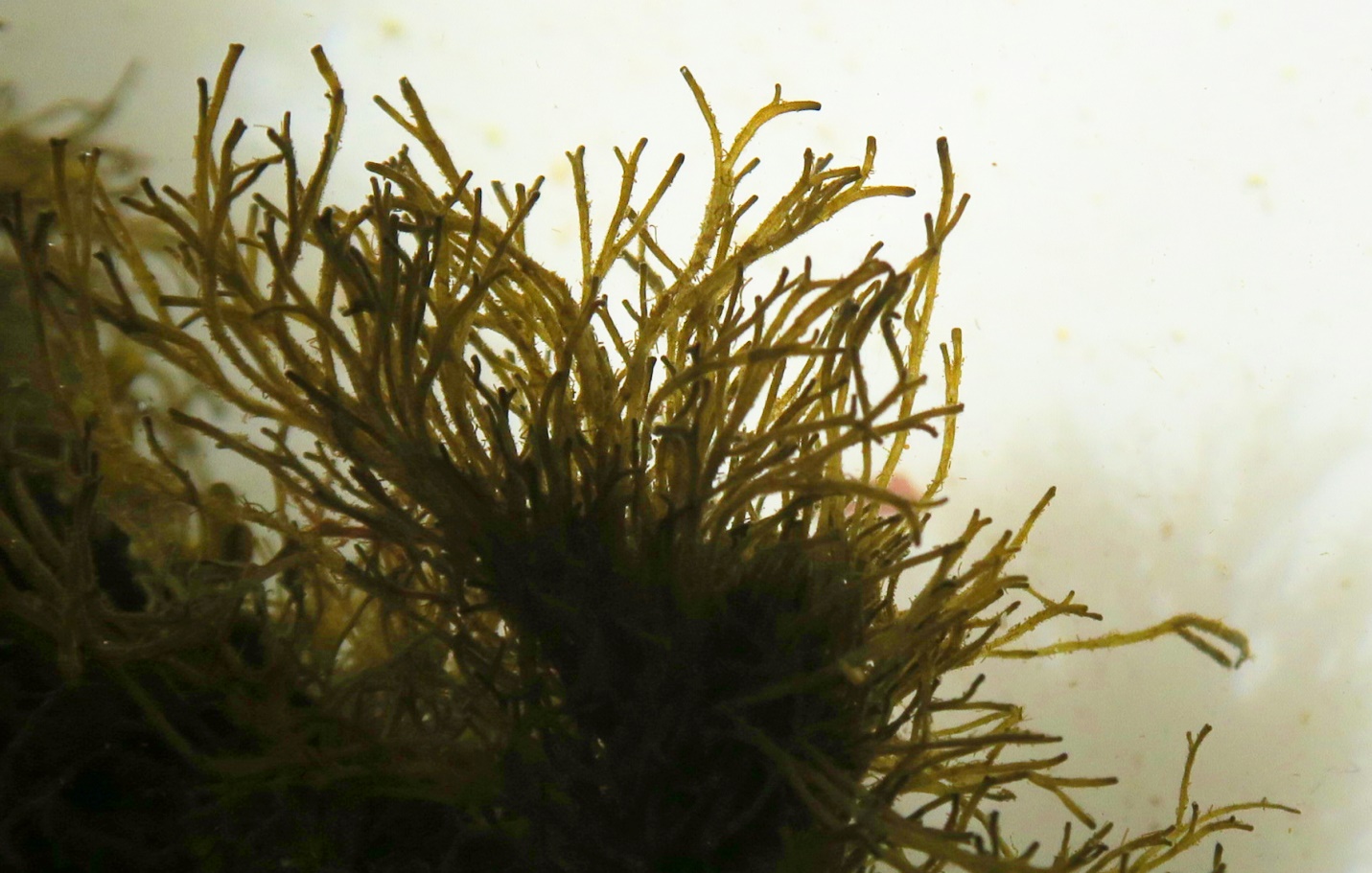
Figure 7: Collected, viewed and photographed in a light bowl, here some of the more microscopic details of the species can be seen. Harling Point, Juan de Fuca Strait, Vancouver Island, B.C., Canada. July 10, 2021. Photo ID 27742 ©Seaweedwhisperings.com
Biology & Natural History Information:
Description:
Thalli tufted, attached basally by prostrate or rhizoidal portion, light to medium brown or yellowish in color, with very finely branched uniseriate filaments to 60 µm diameter and reaching up to 8 cm (3 in) tall. Branches taper; pseudo dichotomously branched below, and more or less alternately arranged above. True hairs lacking, but plurangia (gamete producing reproductive structures) form long multicellular extensions from short pedicels. The cells have several irregularly ribbon-like chloroplasts per cell.
Habitat:
This brown alga is usually epiphytic on other algae in low intertidal sheltered habitats in mid to late summer.
North Pacific Distribution:
Arctic coast of Alaska south to central California; Korea; Japan.
Remarks:
This rather small epiphytic seaweed is one that has a large number of references and studies to its name – the list is surprisingly ‘bulky’ compared to some much larger, more commonly recognizable species. In fact, its genome was the first macro algal genome of the brown alga group to be sequenced. In suitable conditions, species of Ectocarpus can be bloom-forming macroalgae. Algal blooms arise as natural events or a consequence of increased nutrient loading into aquatic environments by human activity. If the products of such ‘blooms’ are consumed by herbivores and carnivores, the over-production of the bloom is passed along as valuable energy in the food chain. However, if portions of the primary bloom are not consumed, they can accumulate as organic matter in sediments of the substrate and over a few seasons such incremental changes can lead to changes in the species composition and macro algal abundance in the affected region. They can usher in change. Macro algal blooms are most commonly noted by even the casual observer when the masses of attached or floating thalli become stranded – they can form highly malodorous rotting masses on beaches.
Classification:
Phylum: Heterokontophyta
Subphylum: Ochrophytina
Class: Phaeophyceae
Subclass: Fucophycidae
Order: Ectocarpales
Family: Ectocarpaceae
Genus: Ectocarpus
Species: Ectocarpus siliculosus (Dillwyn) Lyngbye 1819
Former name(s):
Basionym: Conferva siliculosa Dillwyn.

Figure 8: Blades of various macro algae are seen here. While it is late season for the annual growth of many of the large kelp and even the Mazzaella splendens, this is prime season for the Ectocarpus siliculosus. Harling Point, Juan de Fuca Strait, Vancouver Island, B.C., Canada. August 31, 2024. Photo ID 27743 ©Seaweedwhisperings.com
![]()